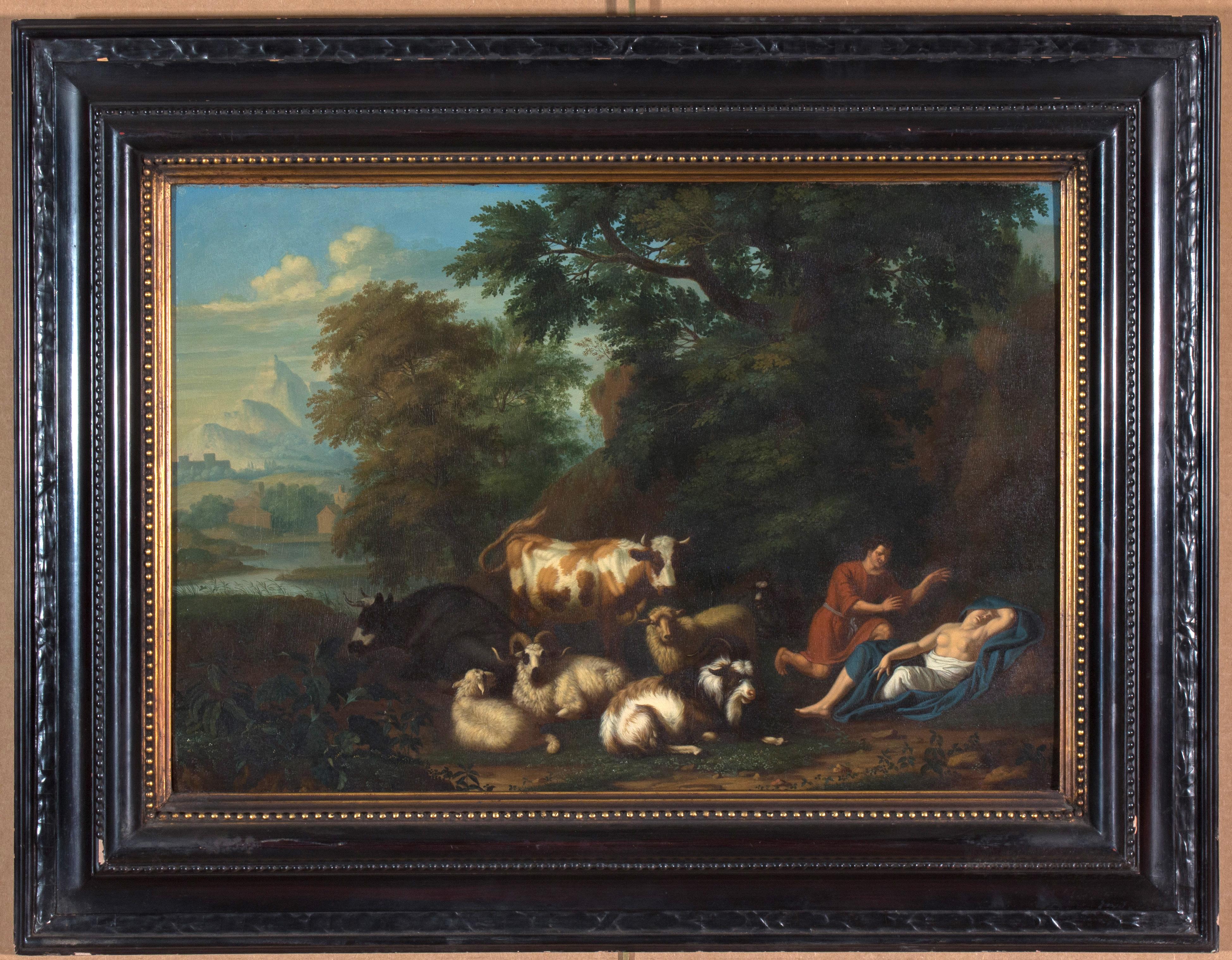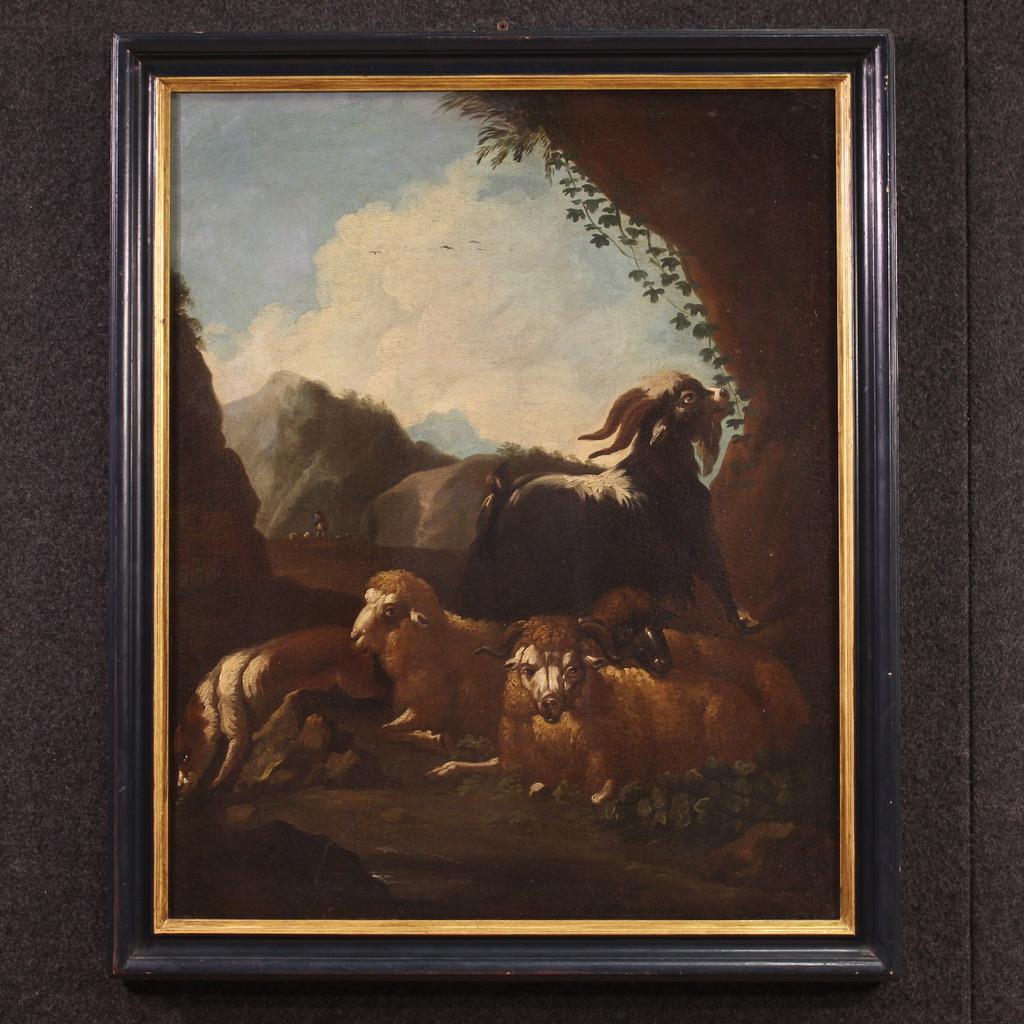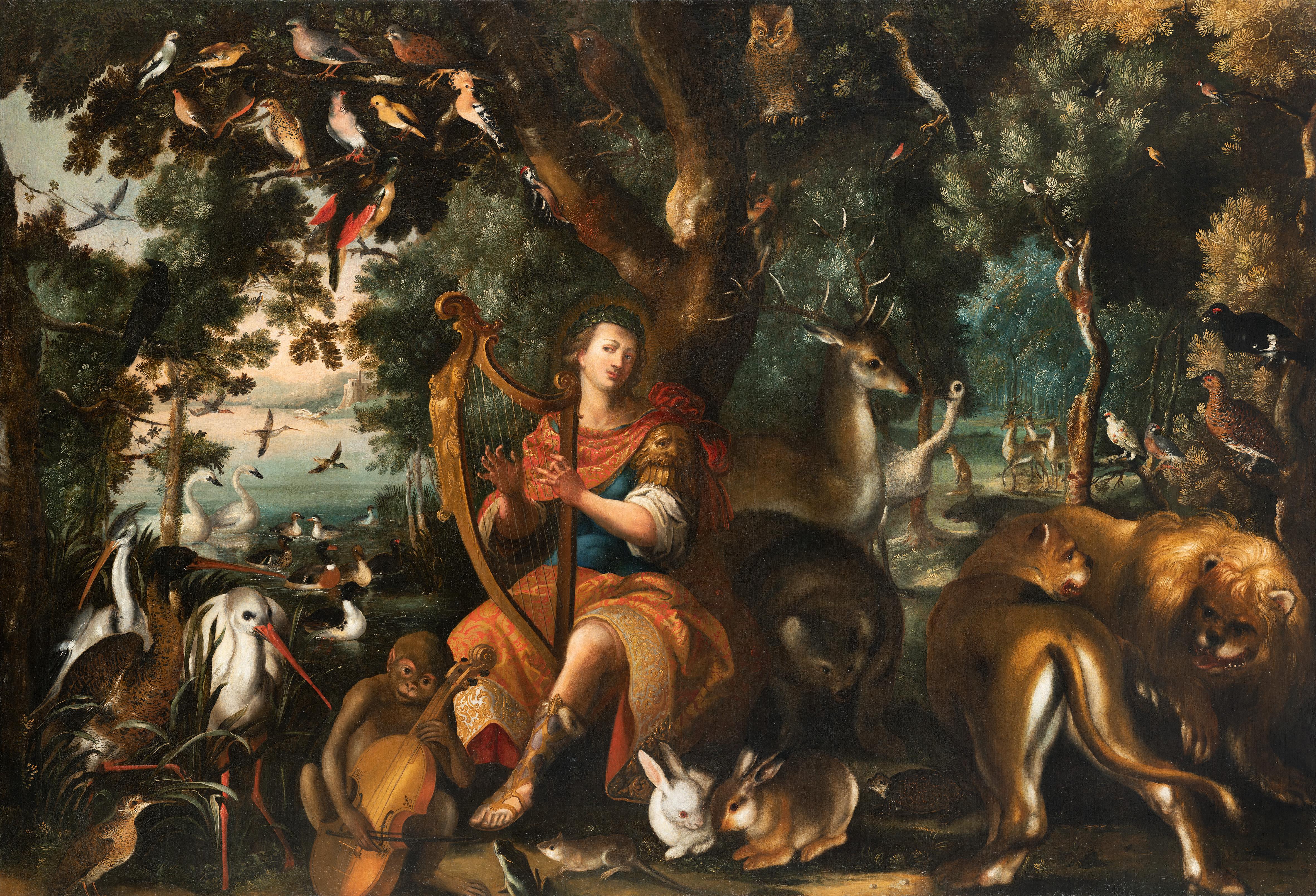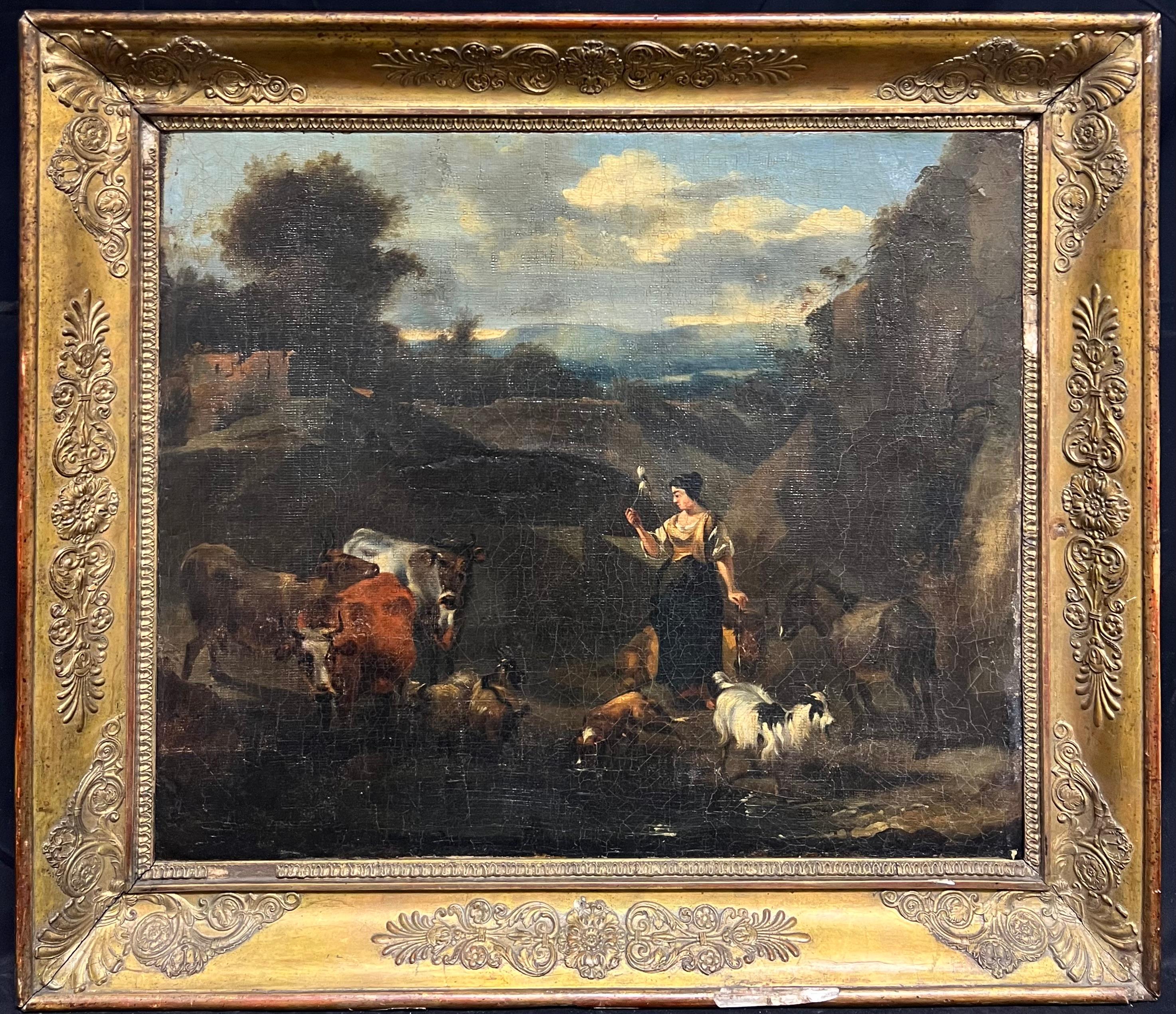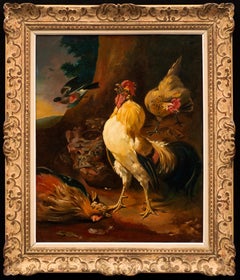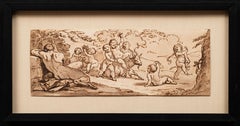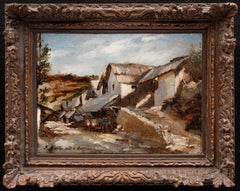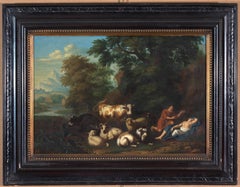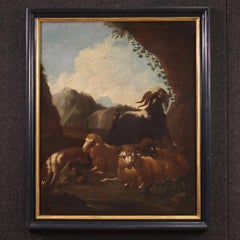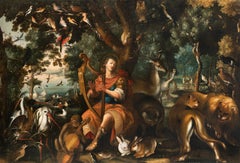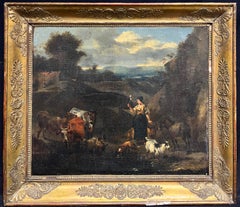Items Similar to "Earthly Paradise" Frédérick Bouttats (Antwerp, 1590-1661)- Studio of
Video Loading
Want more images or videos?
Request additional images or videos from the seller
1 of 14
"Earthly Paradise" Frédérick Bouttats (Antwerp, 1590-1661)- Studio of1610-1612
1610-1612
$57,500
£43,675.95
€50,329.50
CA$80,974.24
A$89,771.92
CHF 47,178.65
MX$1,098,661.07
NOK 589,213.32
SEK 553,035.66
DKK 375,678.47
About the Item
The Earthly Paradise
Frédérick Bouttats (Antwerp, 1590-1661)
Painting is Circa 1610-1612
Oil on wood panel, circa 42 7/8 x 29 3/8 (ca. 52 x 39 frame) inches
The inner frame is c18th century with contemporary frame stacked over the earlier frame.
Provenance:
Private European collection
Sotheby’s Paris
Private Collection; Paris France
Private collection; United States
The painting Earthly Paradise by Frédérick Bouttats (Active 1612-1661, workshop of) is a stunning work of art that captures the beauty and diversity of nature on a single canvas. This 17th century masterwork is an outstanding example of the Flemish Baroque style, characterized by its exuberance, richness and complexity. It is based in part on a famous painting Jan Brueghel the Elder (Brussels, 1568-1625) which was executed in around 1610.
The composition of the painting is very interesting, as it presents a wide variety of natural elements, such as trees, flowers, animals and landscapes. The artist uses a layering technique to create a sense of depth and three-dimensionality in the image. The attention to detail is exceptional, and each element is rendered with impressive precision.
Color is another prominent aspect of the painting; Bouttats uses a bright, richly saturated color palette to create a sense of vitality and energy in the image. Green, red, and blue tones are particularly vibrant, and are used to represent vegetation, animals, and the sky.
The story behind the original Breughel painting is equally as fascinating. It is believed to have been commissioned by Archduke Albert of Austria in the 17th century and has been kept in the collection of the Spanish royal family ever since. The image represents the earthly paradise, a popular theme in religious art of the time. Though the scene seems to be a reference to Genesis 2:8–14 which hosts a variety of animals, presumably 100, from diverse ecosystems. However, the figures seem to be an apparition of the Babylonian King, Nebuchadnezzar (605 BCE-562 BCE) eating grass having been punished by God for his pride.
“The same hour was the thing fulfilled upon Nebuchadnezzar: and he was driven from men, and did eat grass as oxen, and his body was wet with the dew of heaven, till his hairs were grown like eagles’ feathers, and his nails like birds’ claws.”
It has also been suggested that the image could have been used as a teaching tool for religious education though the addition of Nebuchadnezzar creates more questions than answers at this point. Clearly, further research is required.
In summary, this painting The Earthly Paradise is an exceptional work of art that combines natural beauty with artistic complexity. Its Flemish Baroque style, its detailed composition, its vibrant color and its fascinating history make it an outstanding painting from the 17th century.
Frédérick Bouttats was born in Antwerp in 1590. He was a pupil of the painter and hart dealer Matthijs Willenhoudt; Bouttats was mentioned as an apprentice. Later, he became a master of the Guild of Saint Luke in Antwerp in 1612.
Works of art by Frédérick Bouttats can be found in numerous international institutions such as: National Gallery of Art, Washington, D.C.; National Portrait Gallery, London; Royal Collection Trust, United Kingdom; The Morgan Library and Museum, New York City, etc.
- Creation Year:1610-1612
- Dimensions:Height: 39 in (99.06 cm)Width: 52 in (132.08 cm)
- Medium:
- Movement & Style:
- Circle Of:Frédérick Bouttats (1590 - 1661, Dutch)
- Period:
- Condition:The painting is structural sound having recently been cleaned with areas of touch up. The reverse has been enhanced with supports and ameliorate any splitting of the wood panel. The inner frame is period, 18th century hand painted animal print design.
- Gallery Location:SANTA FE, NM
- Reference Number:1stDibs: LU1408216145692
About the Seller
5.0
Gold Seller
Premium sellers maintaining a 4.3+ rating and 24-hour response times
Established in 1995
1stDibs seller since 2020
121 sales on 1stDibs
Typical response time: 1 hour
- ShippingRetrieving quote...Shipping from: Santa Fe, NM
- Return Policy
Authenticity Guarantee
In the unlikely event there’s an issue with an item’s authenticity, contact us within 1 year for a full refund. DetailsMoney-Back Guarantee
If your item is not as described, is damaged in transit, or does not arrive, contact us within 7 days for a full refund. Details24-Hour Cancellation
You have a 24-hour grace period in which to reconsider your purchase, with no questions asked.Vetted Professional Sellers
Our world-class sellers must adhere to strict standards for service and quality, maintaining the integrity of our listings.Price-Match Guarantee
If you find that a seller listed the same item for a lower price elsewhere, we’ll match it.Trusted Global Delivery
Our best-in-class carrier network provides specialized shipping options worldwide, including custom delivery.More From This Seller
View All"A Triumphant Cockerel Crowing Over His Victory" Melchior Hondecoeter (after)
Located in SANTA FE, NM
"The Victor (A Triumphant Cockerel Crowing Over His Victory...)"
After Melchior de Hondecoeter (Flemish, 1636-1695)
Oil on canvas
Unsigned
40 1/2 x 34 1/4 (frame) inches
This much copied painting is a masterfully executed portrait of a strutting and triumphant rooster painted...
Category
Early 1900s Old Masters Animal Paintings
Materials
Canvas, Oil
Antique Italian School Late 17th - Early 18th "Cherubs (A)" Pen drawing of Putti
Located in SANTA FE, NM
"Cherubs" (A)
Pen and Ink drawing of Putto
Italian School
Late 17th early 18th century.
Pen and ink on paper
6 ½ x 17 ½ (22 ½ x 11 ½) inches
Antique scenes of putto and a faun cele...
Category
Late 17th Century Old Masters Figurative Paintings
Materials
Paper, Ink, Pen
"Study from Nature Made in Montfaucon 1846" François Bonvin (1817-1888)
By François Bonvin
Located in SANTA FE, NM
Study from Nature Made in Montfaucon 1846
(Etude d'après Nature Faite à Montfaucon, 1846)
François Bonvin (French, 1817-1887)
Oil on canvas, original hand carved wood frame.
Signed, dated and inscribed F. Bonvin 1846 a Montfaucon (ll); inscribed indistinctly Etude... F. Bonvin...montfaucon on the stretcher
6 3/8 x 8 5/8 (9 1/2 x 11 1/2 frame) inches
Provenance:
Ex Collection Auguste Péquégnot
Paul Prouté
André Watteau
Charles Sadler
Galerie Berès, Paris
Exhibited:
Paris, Galerie Beres, Francois Bonvin, Nov. 20, 1998 - Jan. 9, 1999
Literature:
International Herald Tribune, Nov. 28-29, 1998, p. 9, illus.
Bonvin's work has been compared with that of the eighteenth-century artist Chardin, whom Bonvin greatly admired, and from whose work he often borrowed particular motifs. Amongst the artists he personally encouraged were Théodule Ribot and Fantin-Latour.
He was one of a group of artists who challenged the idea that still-life was a mode of artistic expression inferior to the lofty genre of history and religious painting. Bonvin championed the Realist conviction that everyday subject matter was the trues form of artistic expression.
Bonvin was known for keen observation skills and great restraint. In his paintings, you can almost feel the moment between breaths as the subject matter is contemplated and then committed to canvas. This a superb, very personal and very quiet study of the village of Montfaucon on what appears to be an afternoon in the Argonne region in Northeastern France known its deep valleys and dense woodlands.
François is one of the most interesting painters of the 19th century. Bonvin was born in humble circumstances in Paris and had a very difficult childhood. He was the son of a police officer and a seamstress; when he was four years old his mother died of tuberculosis. Young François was left in the care of an old woman who underfed him. Soon his father married another seamstress and brought the child back into the household. Nine additional children were born (one of whom was his half-brother, the painter Leon...
Category
Mid-19th Century Realist Landscape Paintings
Materials
Canvas, Oil
18th Century European Portrait of Saint John the Baptist as a Child.
Located in SANTA FE, NM
18th Century European Portrait of a Child Saint John the Baptist
Oil on Canvas
19 x 14 1/4 inches
This lovely and sensitively painting has been examined by a professional restorer w...
Category
18th Century Old Masters Figurative Paintings
Materials
Canvas, Oil
Pair of Hunting Dogs at Rest; artist unknown, French, Mid-19th century
Located in SANTA FE, NM
Pair of Hunting Dogs at Rest;
Artist unknown, French, 19th century (monogrammed "JS"
Circa 1850
10 x 7 (14 3/8 x 17 1/8 frame) inches
This is finely realized portrait of pair of h...
Category
1830s Romantic Animal Paintings
Materials
Oil, Wood Panel
"Le Trianon à Versailles, 1925" Louis Gautier (French, 1855-1947)
Located in SANTA FE, NM
"Le Trianon à Versailles, 1925"
Louis Gautier (French, 1855-1947)
Oil on cardboard
Provenance: Private Collection Marseille, France
Signed and dated 1925 lower right. Titled, dated...
Category
1920s Landscape Paintings
Materials
Oil, Cardboard
You May Also Like
An Eighteenth Century Pastoral Scene by Jan van Gool, 1719
Located in Philadelphia, PA
Jan van Gool
(Dutch, 1685-1763/65)
Pastoral Scene, 1719
Oil on panel, 15 x 21 3/4 inches
FRAMED: 23 x 29 1/2 (Approx.)
Signed and dated at lower left: "J V G...
Category
1710s Old Masters Landscape Paintings
Materials
Oil, Panel
17th Century Oil on Canvas Bucolic Landscape with Animals Painting, 1680
By Philipp Peter Roos (Rosa di Tivoli)
Located in Vicoforte, IT
Elegant painting from the second half of the 17th century. Oil on canvas artwork depicting a splendid landscape with grazing animals, of great pictorial quality. In the foreground we...
Category
1680s Landscape Paintings
Materials
Canvas, Oil
Flemish 17th, Orpheus and Animals, Large Decorative Wall Old Master Painting
Located in Greven, DE
Flemish school, 17th century
Orpheus and the animals
Oil on canvas, 146,5 x 217 cm
Provenance: South German private collection.
On an impressive, room-filling format, this painting depicts "Orpheus and the Animals."
The harp-playing Orpheus sits centrally in front of a tree whose trunk bifurcates above his head. This central tree frames with its crown the scenery towards the horizon and at the same time offers through branches the possibility for many birds to find space. The left half of the picture is characterized by a seascape, at the edge of which the ruins of a castle can be seen deep in the background. This seascape, framed by mountains on the horizon, is the only area where sky can be seen. On this side, waterfowl such as storks, swans and ducks can be seen. In the right half, the viewer looks into a deep European forest. On this right side, more land animals can be found, such as deer, rabbits and lions, among others. Orpheus wears opulent red and gold trimmed clothing, under his blue breastplate we see a white shirt. His feet are adorned by elaborate sandals. His head is surrounded by a radiant laurel wreath ("poeta laureatus"). The young man is clearly identifiable as the singer and poet of Greek mythology, Orpheus, by his harp, the laurel wreath and the animals surrounding him.
Orpheus was one of the Argonauts who, under Jason, was searching for the Golden Fleece. He sang so beautifully that he even conquered the angry sea and enemies by the magic of his lyre. During the journey, Orpheus is said to have drowned out even the sirens with his singing. It is said that he was the greatest of all poets and charmed people, animals, stones and trees with his singing.
In total, 51 birds and 37 different species are depicted in the painting. The animals are mostly depicted in great detail and, except for a few, can be identified. Mainly European species of animals are shown. Exceptions are the ostrich-like nandu peeking out from behind the deer, as well as the large parrot on the upper left, and the two lions. Similar is the case for the large animal directly behind Orpheus on the right. The shape of the head suggests an arctic fox from the polar regions, even though the body is much too large. The arctic fox was first described in 1555 by Olaus Magnus. However, it could also be a depiction of a brown or black bear.
An unusual detail is the animal, which is relatively isolated in the right background and looks to the left. It is not clearly identifiable, but it shows certain similarities with the Australian kangaroo. This was first described by Vespucci in 1500 and further by Francisco Pelsaert in 1629. If it is indeed a kangaroo, this would be one of the earliest surviving pictorial representations.
In this painting, Orpheus is accompanied by a small monkey playing a viola da gamba. This is an iconographic peculiarity. In general, this painting has some peculiarities compared to other paintings with "Orpheus and the animals". The central positioning of Orpheus is quite common, but he usually holds a lyre and is dressed in an antique style, but not as opulently. The choice of animals is also remarkable: European animals in particular are seen, hardly any exotic features, such as camels or elephants.
The two lions in the right foreground are a quotation from Peter Paul Rubens and his depiction of "Daniel in the Lion's Den", which was realized in an engraving.
The present painting can be classified as belonging to the Flemish School of the 17th century on the basis of its painterly and compositional conception. From the circle of Jan Brueghel the Younger are numerous representations of this Orpheus - theme, which take it as an opportunity to show as many exotic animals. There are also echoes of Spanish painters such as Juan de Arellano...
Category
17th Century Baroque Landscape Paintings
Materials
Canvas, Oil
Large 17th Century Dutch Old Master Oil Painting Figures Animals Landscape
Located in Cirencester, Gloucestershire
Follower of Dirck van Berghen (Dutch School, 17th Century)
Pastoral Landscape with a Shepherdess and Livestock
Oil on canvas, framed in a French Empire period gilt frame
canvas dimensions: 18 x 22 inches
framed dimensions: 22.5 x 26 inches
This charming pastoral scene, rendered in oil on canvas, is attributed to a follower of the 17th-century Dutch painter Dirck van Berghen, who was known for his bucolic landscapes featuring cattle and rural life. The composition reflects the influence of van Berghen’s mentor, Adriaen van de Velde...
Category
17th Century Old Masters Figurative Paintings
Materials
Oil
Dutch or Flemish Landscape with Figures & Animals
Located in Milford, NH
A beautifully detailed late 17th or early 18th century Dutch or Flemish landscape with cows grazing in the water, goats, dogs, and other animals near the water’s edge, under the watchful eye of the herdsmen, on a backdrop of rolling hills and trees. Oil on wood panel, unsigned, and housed in a Rudolph...
Category
Late 17th Century Flemish School Landscape Paintings
Materials
Oil, Wood Panel
Landscape Reder 17/18th Century Pait OIl on canvas Old master
Located in Riva del Garda, IT
Christian Reder (Leipzig 1656 - Rome 1729)
Landscape with boar hunting
Oil on canvas 66 x 132 cm In frame 76 x 143 cm
We present this delightful work, of which the matching ...
Category
17th Century Old Masters Paintings
Materials
Oil
$6,057 Sale Price
20% Off
More Ways To Browse
Royal Collection Trust
Flemish Baroque
Spanish Baroque Art
Flemish Flower Painting
Antique Paradise
Antique Tills
Baroque French Landscape
Antique Painting Tools
Eagle Feather
C Frederick Oil Painting
Eagle Oil Painting
Antique Feather Tree
Antique Eagle Painting
Bird Of Paradise Flower
17th Century Oil On Panel Portrait
Bird Of Paradise Feathers
Jan King
Painting Oxen
